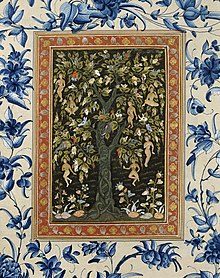
The Muslim period in the Indian subcontinent or Indo-Muslim period is conventionally said to have started in 712, after the conquest of Sindh and Multan by the Umayyad Caliphate under the military command of Muhammad ibn al-Qasim. It began in the Indian subcontinent in the course of a gradual conquest. The perfunctory rule by the Ghaznavids in Punjab was followed by Ghurids, and Sultan Muhammad of Ghor is generally credited with laying the foundation of Muslim rule in Northern India.
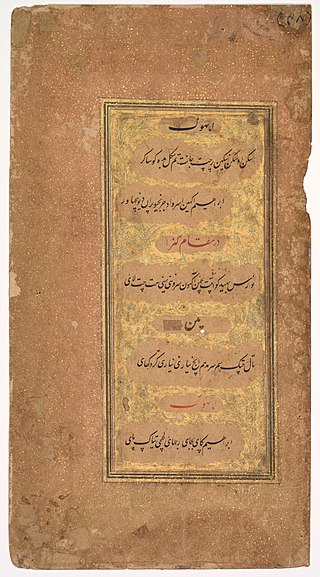
Deccani is an Indo-Aryan language based on a form of Hindustani spoken in the Deccan region of south-central India and is the native language of the Deccani people. The historical form of Deccani sparked the development of Urdu literature during the late-Mughal period. Deccani arose as a lingua franca under the Delhi and Bahmani Sultanates, as trade and migration from the north introduced Hindustani to the Deccan. It later developed a literary tradition under the patronage of the Deccan Sultanates. Deccani itself came to influence modern standard Urdu and later Hindi.

The Deccan sultanates is a historiographical term referring to five late medieval to early modern Indian kingdoms on the Deccan Plateau between the Krishna River and the Vindhya Range that were created from the disintegration of the Bahmani Sultanate and ruled by Muslim dynasties: namely Ahmadnagar, Berar, Bidar, Bijapur, and Golconda. The five sultanates owed their existence to the declaration of independence of Ahmadnagar in 1490, which was followed by Bijapur and Berar in the same year. Bidar became independent in c. 1492, and Golconda in 1512.

The Sultanate of Golconda was an early modern kingdom in southern India, ruled by the Persianate, Shia Islamic Qutb Shahi dynasty of Turkoman origin. After the decline of the Bahmani Sultanate, the Sultanate of Golconda was established in 1518 by Quli Qutb Shah, as one of the five Deccan sultanates.

Ibrahim Qutb Shah Wali, also known by his Telugu names Malki BhaRama and Ibharama Chakravarti, was the fourth monarch of the kingdom of Golconda in southern India. He was the first of the Qutb Shahi dynasty to use the title "Sultan". He ruled from 1550 to 1580. He lived for seven years in exile at the court of Vijayanagara as an honoured guest of Rama Raya. Ibrahim is known for patronizing Telugu extensively because he was moved by a genuine love for the language.

The Sultanate of Bijapur was an early modern kingdom in the western Deccan and South India, ruled by the Adil Shahi or Adilshahi dynasty. Bijapur had been a taraf (province) of the Bahmani Kingdom prior to its independence in 1490 and before the former's political decline in the last quarter of the 15th century. It was one of the Deccan sultanates, the collective name of the five successor states of the Bahmani Kingdom. At its peak, the Sultanate of Bijapur was one of the most powerful states in South Asia, second to the Mughal Empire, which conquered it in 1686 under Aurangzeb.

Abdullah Qutb Shah was the seventh ruler of the kingdom of Golconda in southern India under the Qutb Shahi dynasty. He ruled from 1626 to 1672.

Abul Hasan Qutb Shah, also known as Abul Hasan Tana Shah was the eighth and last ruler of the Qutb Shahi dynasty, sovereign of the Kingdom of Golconda in South India. He ruled from 1672 to 1686. The last Sultan of this Shia Islamic dynasty, Tana Shah is remembered as an inclusive ruler. Instead of appointing only Muslims as ministers, he appointed Brahmin Hindus such as Madanna and Akkanna brothers as ministers in charge of tax collection and exchequer. Towards the end of his reign, one of his Muslim generals defected to the Mughal Empire, who then complained to Aurangzeb about the rising power of the Hindus as ministers in his Golconda Sultanate. Aurangzeb sent a regiment led by his son, who beheaded Tana Shah's Hindu ministers and plundered the Sultanate. In 1687, Aurangzeb ordered an arrest of Tana Shah, who was then imprisoned at the Daulatabad Fort. He died in prison in 1699.

Mughal painting is a South Asian style of painting on paper confined to miniatures either as book illustrations or as single works to be kept in albums (muraqqa), originating from the territory of the Mughal Empire in the Indian subcontinent. It emerged from Persian miniature painting and developed in the court of the Mughal Empire of the 16th to 18th centuries. Battles, legendary stories, hunting scenes, wildlife, royal life, mythology, as well as other subjects have all been frequently depicted in paintings.

Ibrahim Adil Shah II was Sultan of the Sultanate of Bijapur and a member of the Adil Shahi dynasty. Under his reign the sultanate had its greatest period as he extended its frontier as far south as Mysore. He was a skilful administrator, artist, poet and a generous patron of the arts. He reverted to the Sunni orthodoxy of Islam, but remained tolerant of other religions, including Christianity. However, during his reign high-ranking Shiite immigrants became unwelcome and in 1590, he ordered the confinement of criers who read the khutba in the Shia form. The Adil Shahis under his rule left a tradition of cosmopolitan culture and artistic patronage whose architectural remains are to be seen in the capital city of Bijapur.
The Sultanate of Bidar was an early modern Indian polity that ruled a territory in the central Deccan centred at Bidar. As one of the Deccan sultanates, the sultanate's initial territory corresponded to that of one of the five provinces of the Bahmani Sultanate, and under the rule of Qasim Barid I in 1492 assumed de facto control of state affairs of the Bahmani Sultanate. Leadership passed to his sons; Amir Barid I in 1504 and Ali Barid Shah I in 1542. Starting from the 1580s as a result of Ali's death, a wave of successions occurred in the rulership of the dynasty which ended in 1609 under the last sultan, Amir Barid III. He was eventually defeated in 1619 by Ibrahim Adil Shah II of the Sultanate of Bijapur, who annexed the territory of the Bidar Sultanate into his realm.
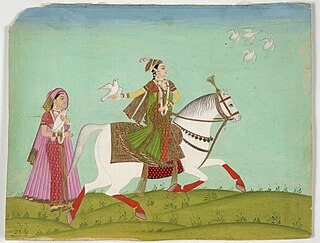
Sultana Chand Bibi was the regent of the Bijapur Sultanate during the minority of Ibrahim Adil Shah II in 1580–1590, and the regent of the Ahmednagar Sultanate during the minority of her great nephew Bahadur Shah in 1595–1600. Chand Bibi is best known for defending Ahmednagar against the Mughal forces of Emperor Akbar in 1595.

Farrukh Beg, also known as Farrukh Husayn, was a Persian miniature painter, who spent a bulk of his career in Safavid Iran and Mughal India, praised by Mughal Emperor Jahangir as "unrivaled in the age."

Mohammed Adil Shah was the seventh sultan of Bijapur, ascending the throne in 1627. During his reign, he assisted the Mughals with their campaigns against the Ahmednagar Sultanate and signed a peace treaty with them in 1636. He died in 1656 and was buried in the Gol Gumbaz.

The Sultanate of Ahmednagar was a late medieval Indian Muslim kingdom located in the northwestern Deccan, between the sultanates of Gujarat and Bijapur, ruled by the Nizam Shahi dynasty. It was established when Malik Ahmed, the Bahmani governor of Junnar, after defeating the Bahmani army led by general Jahangir Khan on 28 May 1490, declared independence and established the Ahmadnagar Sultanate.

Madanna and Akkanna were two Brahmin brothers who rose to prominence in the 17th-century in the final two decades of the Golkonda sultanate. They helped Abul Hasan Qutb Shah come to power, who appointed them as ministers in his court. He made them responsible for collecting jizya taxes from the Hindus – predominant part of the Sultanate's population. By the 1680s, according to the colonial era Dutch India archives, they controlled all the tax collection and the exchequer of the Golkonda Sultanate. According to Gijs Kruijtzer – a historian specializing in Deccan Sultanates, the Madanna and Akkanna brothers can be viewed as early "nationalists" seeking the welfare of their people and the general public. They can also be viewed as "communalists" who criticized the Muslim elites as exploitative who do not care about non-Muslims, who serve the interest of their holy land in Arabia, and seek personal gain. The two brothers spent the taxes they collected in Golconda on the "welfare of the public", states Kruijtzer, which included furthering trade with the colonial Dutch, building public sarai, as well as restoring and building temples.
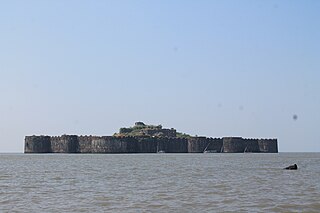
The Deccan sultanates were five early modern kingdoms, namely Bijapur, Golkonda, Ahmadnagar, Bidar, and Berar, which ruled the Deccan Plateau for part of the 15th, and the majority of the 16th–17th centuries. Their architecture was a regional variant of Indo-Islamic architecture, and influenced by the styles of the Delhi Sultanate and later Mughal architecture, but sometimes also influenced from Persia and Central Asia. Hindu temple architecture in the same areas had very different styles.
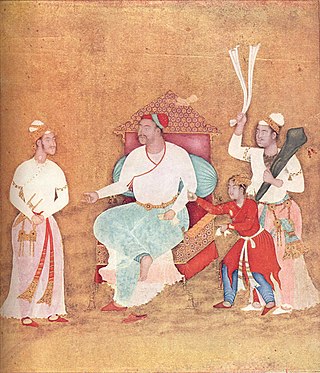
The Deccanis or Deccani people are an Indo-Aryan ethno-religious community of Deccani-speaking Muslims who inhabit or are from the Deccan region of India. The community traces its origins to the shifting of the Delhi Sultanate's capital from Delhi to Daulatabad in 1327 during the reign of Muhammad bin Tughluq. Further ancestry can also be traced from immigrant Muslims referred to as Afaqis, also known as Pardesis who came from Central Asia, Iraq and Iran and had settled in the Deccan region during the Bahmani Sultanate (1347). The migration of Muslim Hindavi-speaking people to the Deccan and intermarriage with the local Hindus who converted to Islam, led to the creation of a new community of Hindustani-speaking Muslims, known as the Deccani, who would come to play an important role in the politics of the Deccan. Their language, Deccani, emerged as a language of linguistic prestige and culture during the Bahmani Sultanate, further evolving in the Deccan Sultanates.

Deccan painting or Deccani painting is the form of Indian miniature painting produced in the Deccan region of Central India, in the various Muslim capitals of the Deccan sultanates that emerged from the break-up of the Bahmani Sultanate by 1520. These were Bijapur, Golkonda, Ahmadnagar, Bidar, and Berar. The main period was between the late 16th century and the mid-17th, with something of a revival in the mid-18th century, by then centred on Hyderabad.

The House of Bijapur is a 17th-century Deccan-style painting, commissioned during the reign of the Bijapur Sultanate. It is currently housed in the Metropolitan Museum of Art in New York City.



